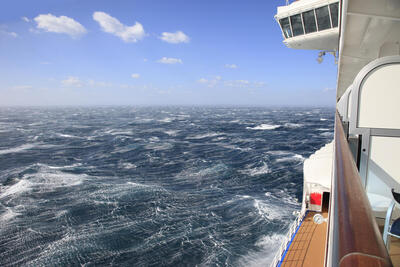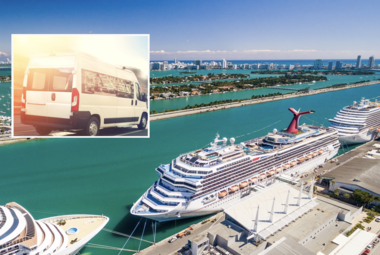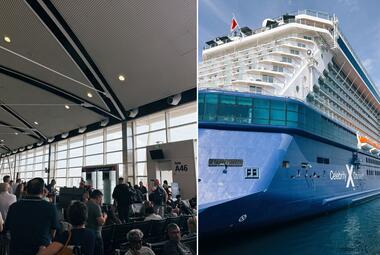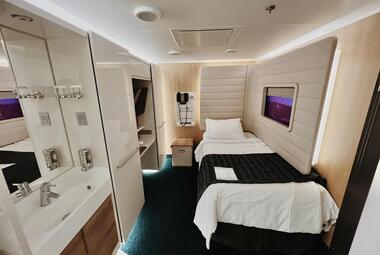Which rough seas should you avoid on your next cruise?
Cruise ships travel all over the world, from the tropical Bahamas to the icy waters of Alaska. As a result, ships navigate through various climates, meaning your packing list will look different depending on your destination.
Not only is the weather different but certain seas can also present challenging conditions, especially for those prone to motion sickness. Plus, the rougher the waters, the more likely that your itinerary will be adjusted.
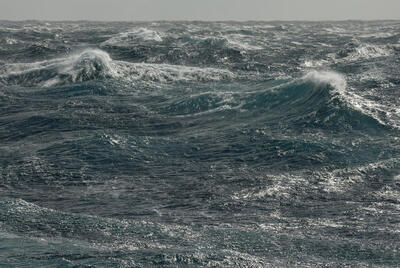
Whether you're looking to take an adventurous trip or are just curious, here's a list of the roughest seas in the world:
🌊 The Drake Passage
🌊 The Bay of Biscay
🌊 The Gulf of Alaska
🌊 The Bering Sea
🌊 The Atlantic Ocean
🌊 The Mediterranean
🌊 The Caribbean
🌊 The Pacific Ocean
🌊 The North Sea
🌊 The South China Sea
The Drake Passage
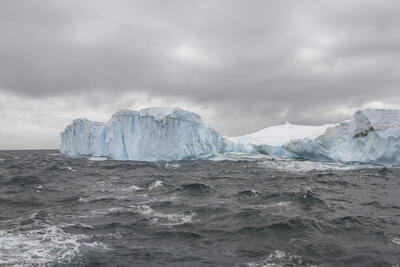
While mainstream cruise lines do traverse through the Drake Passage, those looking to cross off all seven continents will have to board an expedition vessel with hopes of stepping foot in Antarctica.
Where exactly is the Drake Passage, though? it's the body of water that lies between Cape Horn and the South Shetland Islands. In order words, the Drake Passage is what connects the Atlantic and Pacific Oceans.
The lack of nearby landmasses causes strong currents. In fact, the water currents can be as fast as 150 million cubic meters per second in some areas. Combined with the strength of the waves, the Drake Passage is one of the roughest seas in the entire world.
The Bay of Biscay

Those hoping to have a leisurely European cruise should approach the Bay of Biscay with caution, as it's known for bad weather and rough seas.
This body of water, which is located off the west coast of France and northern Spain, is home to parts of the continental shelf that extend far into the bay, resulting in some shallow waters.
Additionally, the Bay of Biscay is known for heavy storms during the winter months, meaning that you can reduce the chance of poor weather by cruising during the summer.
Cruises that often sail through the Bay of Biscay include those sailing from Southampton to Portugal and Spain. Transatlantic voyages that begin in the UK and Northern Europe will often sail south and visit the Azores before beginning to cross the ocean, too.
The Gulf of Alaska
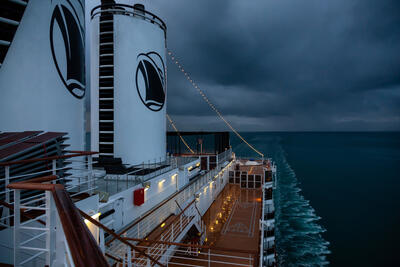
Thankfully, most Alaska cruises will be done within the protected waters of the Inside Passage, as the presence of land provides a good deal of shelter.
Select sailings, however, must cross through the Gulf of Alaska. These waters are rougher due to the strong surface currents and cold air.
Ships subject to traversing through the Gulf of Alaska include those sailing to/from Seward, Whittier, or Anchorage. As these tend to be one-way cruises that visit more remote parts of Alaska, consider a round-trip cruise from Seattle if you want to avoid cruising through the Gulf of Alaska.
Read more: 14 lessons learned after I tried my first Alaska cruise
The Bering Sea

The Bering Sea is found between Alaska and Russia and connects the Arctic Ocean to the Pacific Ocean. It's not the most common sea to sail through on a cruise; however, you'll likely pass through these rough waters on voyages from Vancouver, Canada, to Tokyo, Japan.
It's known for its violent storms and massive waves, especially during the winter. Thankfully, most Bering Sea cruises happen during the spring and fall!
Still, it's best to come prepared for unexpected swells.
The Atlantic Ocean
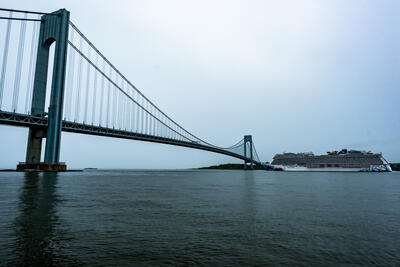
Whenever you cross a large body of water, you're more likely to encounter some rough waves since there's no land nearby to provide any protection.
Typically, the winter months are the most intense. Transatlantic cruises tend to see their roughest waters in November, December, and February. Thankfully, the majority of mainstream cruise lines do not conduct transatlantic cruises in December and February.
If you're going to embark on a transatlantic cruise in the winter, it'll most likely be on either a luxury cruise line like Oceania or Cunard from New York to Southampton and vice versa. Of course, that doesn't mean you won't be impacted at other times throughout the year, particularly during hurricane season.
The Mediterranean
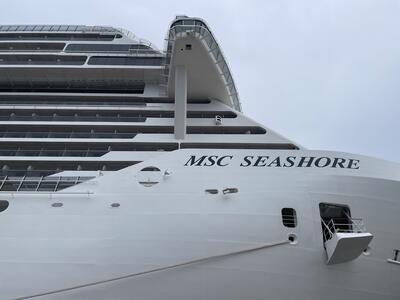
Wanting to stay in the Mediterranean and visit culturally rich ports of call like Barcelona, Rome, Naples, etc.? While the sea itself is relatively sheltered, it can be subject to rough waters in the fall and winter, as this is when the winds are the strongest. Of course, you never know when your ship will encounter random swells in the spring and summer.
As like with the Bay of Biscay, if you want to minimize your chance of rough seas, it's best to cruise during the summer. There are, however, pros to sailing during the winter.
Since there's less of a demand to cruise during these months, you can often find lower rates compared to those in July and August. With the majority of mainstream cruise lines having deployed their fleets to North America, you'll have fewer cruise lines and ships to choose from, though.
Read more: Best time to cruise the Mediterranean
The Caribbean

The Caribbean is one of the most popular year-round cruising destinations for a reason. Nothing quite beaches sinking into the white sand of a famous beach while admiring the turquoise waters with a fruity drink in hand.
Even if you aren't a beach person, the Caribbean is home to numerous ports of call that all offer different excursions, ranging from active ATV tours to breathtaking zipline tours.
During certain months, however, the Caribbean can get rather stormy. If you want to avoid all chances of your cruise being re-routed from an Eastern Caribbean cruise to a Western, don't sail during the busiest hurricane months.
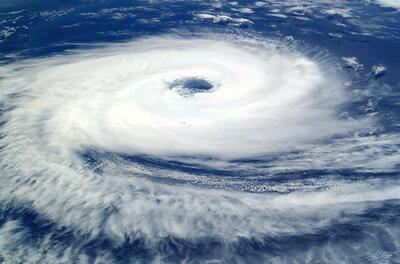
While the season technically lasts from June through the end of November, peak activity usually occurs during August and September.
Additionally, some regions are less likely to be impacted by hurricanes, such as the Southern Caribbean. The majority of hurricanes tend to make landfall in The Bahamas and Eastern Caribbean, including the British Virgin Islands, St. Maarten, Puerto Rico, etc.
In November 2023, I sailed on a 5-night cruise onboard Carnival Vista and felt some of the most intense rocking that I've ever felt on a cruise ship. My cousin and I would often sit still in our cabin and watch the horizon move up and down. Each night, our stateroom would creak with the rocking of the vessel, too.

There were times when we'd be walking from one venue to another and remark about how we felt as though we walking like we had a few too many drinks!
The Pacific Ocean
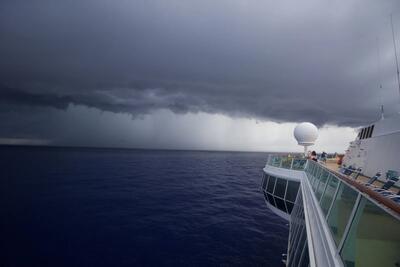
Like the Atlantic Ocean, any crossing over a large body of water with minimal land surrounding it is subject to encountering some rough seas.
The Pacific Ocean, however, is larger than the Atlantic, so it's not uncommon to hear about swells impacting sailings from North America to Hawaii, Australia to Hawaii, etc.
Avoid sailing during February, March, and April to miss the roughest waters.
The North Sea
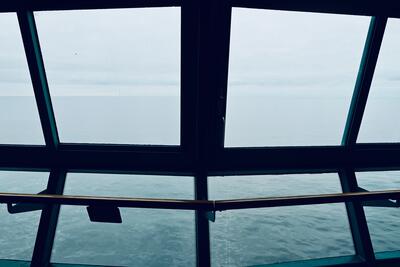
Sailing through the North Sea is often accompanied by rough waters and thick fogs, as it is susceptive to high winds and waves. If you're cruising to North Europe (i.e., Norway), the British Isles, or even Iceland, you'll likely have to voyage through the North Sea.
While trip interruptions are a risk all cruisers take, you don't want to be left with the disappointment of missed ports.
Cruise.Blog writer Hayley experienced first-hand what the rough waters of the North Sea can be like during a cruise to the British Isles in October. Halfway through her voyage, a massive storm swept through the UK, and her scheduled stops in Isle of Man and Dublin were canceled.
"The roughest seas I’ve ever experienced was while sailing onboard Norwegian Star during a British Isles cruise," Hayley said, "Sailing from Southampton to Edinburgh, we passed through an Autumn storm that caused our ship to rock rather aggressively through the night. At one point, our travel companions compared the experience to the feeling of riding a roller coaster!"
Read more: I accidentally booked a cruise on one of the world’s most dangerous seas
The South China Sea
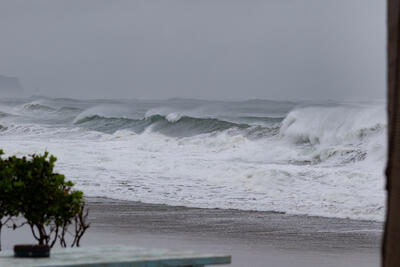
Did you know that mainstream cruise lines are beginning to increase their presence in Asia? Disney Cruise Line, for instance, is homeporting their brand-new ship Disney Adventure in Singapore in December 2025!
Typhoon season in the northwest Pacific Ocean runs from July through November, with the peak occurring in August and September, which is similar to the Atlantic hurricane season. Storms, however, can happen at any point during the year.
The South China Sea is also home to what's known as "The Dangerous Ground," which is an area that is infamously dangerous due to its low islands and sunken reefs that sometimes rise from ocean depths. It's also a poorly charted area and has had its fair share of territorial disputes in the past. Thankfully, it's avoided at all costs on Asian cruises, regardless of embarkation port.
Don't worry, cruising in rough seas is completely safe

Despite horror stories you may have heard about cruising during storms, it's totally safe. Cruise lines have teams that actively monitor the weather, and ships will do their best to reasonably sail around any storms that pop up.
Stabilizers are a crucial component of any cruise ship. Their primary function is to minimize the amount of rocking guests feel while onboard. These fins or rotors lie beneath the water line and extend from the ship's hull. The newer the cruise ship, the more advanced the stabilizer system is.
That, however, doesn't mean you won't feel mega-ships rocking. Once while onboard Symphony of the Seas, barf bags were placed in every stairwell due to how insane the waves were.
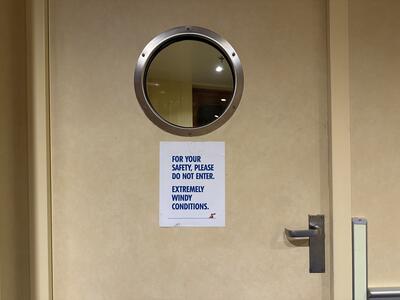
Sometimes, the cruise ship's Captain will restrict passengers from going outdoors. This happened on my cruise onboard Carnival Vista. Our stateroom was located at the very front of the ship on Deck 9 near a public observation deck, and throughout the entire sailing, there was a sign that read, "For your safety, please do not enter. Extremely windy conditions."
Regardless of when and where you're cruise is, it's best to come prepared with some motion sickness remedies, such as over-the-counter medications like Bonine or Dramamine.
You can also book a stateroom that's located in the middle of the ship, as this helps to act as an "equilibrium point." Additionally, the stateroom should be located on a lower deck because they tend to feel less motion than those on higher decks.


